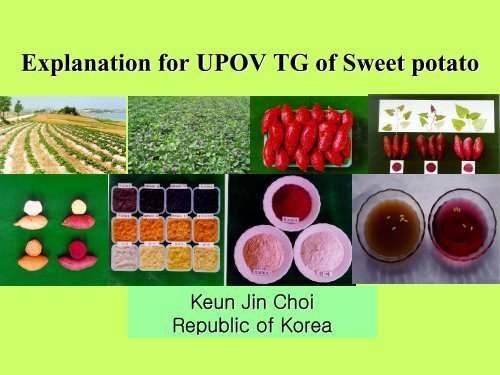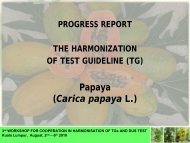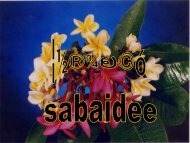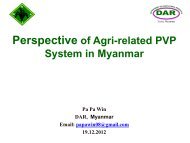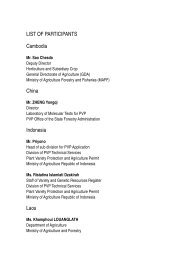Explanation for UPOV TG of Sweet potato
Explanation for UPOV TG of Sweet potato
Explanation for UPOV TG of Sweet potato
Create successful ePaper yourself
Turn your PDF publications into a flip-book with our unique Google optimized e-Paper software.
<strong>Explanation</strong> <strong>for</strong> <strong>UPOV</strong> <strong>TG</strong> <strong>of</strong> <strong>Sweet</strong> <strong>potato</strong>Keun Jin ChoiRepublic <strong>of</strong> Korea
History <strong>of</strong> Development <strong>of</strong> <strong>TG</strong> <strong>Sweet</strong> <strong>potato</strong>Draft : 6 th Asian Regional Technical Meeting (6 th ARTM),in Singapore, 20051 st Proj. : 35 th TWA, in Beijing China, 20062 nd Proj. : 36 th TWA, in Budapest, Hungary, 20073 rd Proj. : 41 st TWO in Wageningen, Netherlands, 2008-42 nd TWV in Cracow, Poland, 2008-37 th TWA in Nelspruit, South Africa, 20084 th Proj. : 43 rd TWV in Beijing, China, 2009-38 th TWA in Seoul, Republic <strong>of</strong> Korea, 2009Adoption : Technical Committee at its <strong>for</strong>ty-sixth session,in Geneva from March 22 to 24, 2010
Cultivation <strong>of</strong> SWEETPOTATO• Sprouting and production <strong>of</strong> Seedling- Optimum temp. <strong>for</strong> sprouting is 30-33’C- Optimum temp. <strong>for</strong> growing is 23-25’C- production <strong>of</strong> seedling 30~40cm after30~40 days growing• Transplanting and growing-cutting
Development <strong>of</strong> Roots40 days after planting 70 days after planting 90 days after plantingHarvesting is from 120 days after planting
Development <strong>of</strong> New Varieties• Crossing between lines which has flower• Induce flowering- Morning glory can be used as a rootstock-Inducing artificially : treatment short day length, crafting etc.• Selection <strong>of</strong> good quality line• Propagation by vegetative way
SWEET POTATO<strong>UPOV</strong> Code: IPOMO_BATIpomoea batatas (L.) Lam.*GUIDELINESFOR THE CONDUCT OF TESTS FORDISTINCTNESS, UNIFORMITY ANDSTABILITY(DUS)The purpose <strong>of</strong> these guidelines (“Test Guidelines”) is to elaborate theprinciples contained in the General Introduction (document <strong>TG</strong>/1/3),and its associated <strong>TG</strong>P documents, into detailed practical guidance<strong>for</strong> the harmonized examination <strong>of</strong> distinctness, uni<strong>for</strong>mity and stability(DUS) and, in particular, to identify appropriate characteristics <strong>for</strong> theexamination <strong>of</strong> DUS and production <strong>of</strong> harmonized variety descriptions.
TABLE OF CONTENTS1. SUBJECT OF THESE TEST GUIDELINES2. MATERIAL REQUIRED3. METHOD OF EXAMINATION4. ASSESSMENT OF DISTINCTNESS, UNIFORMITY AND STABILITY5. GROUPING OF VARIETIES AND ORGANIZATION OF THE GROWINGTRIAL6. INTRODUCTION TO THE TABLE OF CHARACTERISTICS7. TABLE OF CHARACTERISTICS8. EXPLANATIONS ON THE TABLE OF CHARACTERISTICS9. LITERATURE10. TECHNICAL QUESTIONNAIRE
1. Subject <strong>of</strong> these Test GuidelinesThese Test Guidelines apply to all varieties <strong>of</strong> Ipomoeabatatas (L.) Lam.. However, additional characteristicsmay be needed in order to examine ornamental varieties.
2. Material Required1. The material is to be supplied in the <strong>for</strong>m <strong>of</strong>medium size storage roots, or in the <strong>for</strong>m <strong>of</strong> cuttings.2. The minimum quantity <strong>of</strong> plant material, to besupplied by the applicant, should be: 50 storage rootsor 150 cuttings.3.The plant material supplied should be visibly healthy,not lacking in vigor, nor affected by any importantpest or disease.
3. Method <strong>of</strong> Examination1. Number <strong>of</strong> Growing CyclesThe minimum duration <strong>of</strong> tests should normally be a single growing cycle.2. Testing PlaceTests are normally conducted at one place. In the case <strong>of</strong> tests conducted atmore than one place, guidance is provided in <strong>TG</strong>P/9 “ExaminingDistinctness.”3. Type <strong>of</strong> observationThe recommended method <strong>of</strong> observing the characteristic is indicated by thefollowing key in the second column <strong>of</strong> the Table <strong>of</strong> Characteristics:MG: single measurement <strong>of</strong> a group <strong>of</strong> plants or parts <strong>of</strong> plantsMS: measurement <strong>of</strong> a number <strong>of</strong> individual plants or parts <strong>of</strong> plantsVG: visual assessment by a single observation <strong>of</strong> a group <strong>of</strong> plants or parts<strong>of</strong> plantsVS: visual assessment by observation <strong>of</strong> individual plants or parts <strong>of</strong> plants
3.4 Test Design1. Each test should be designed to result in a total <strong>of</strong> at least 50plants, which should be divided between at least two replicates.2. Number <strong>of</strong> Plants / Parts <strong>of</strong> Plants to be ExaminedUnless otherwise indicated, all observations on single plantsshould be made on 30 plants or parts taken from each <strong>of</strong> 30 plantsand any other observations made on all plants in the test.3. Additional TestsAdditional tests, <strong>for</strong> examining relevant characteristics, may beestablished.
4. Assessment <strong>of</strong> Distinctness, Uni<strong>for</strong>mity and StabilityDistinctness1. Consistent DifferencesThe differences observed between varieties may be so clear that more than onegrowing cycle is not necessary. In addition, in some circumstances, theinfluence <strong>of</strong> the environment is not such that more than a single growing cycleis required to provide assurance that the differences observed between varietiesare sufficiently consistent. One means <strong>of</strong> ensuring that a difference in acharacteristic, observed in a growing trial, is sufficiently consistent is toexamine the characteristic in at least two independent growing cycles.2. Clear DifferencesDetermining whether a difference between two varieties is clear depends onmany factors, and should consider, in particular, the type <strong>of</strong> expression <strong>of</strong> thecharacteristic being examined, i.e. whether it is expressed in a qualitative,quantitative, or pseudo-qualitative manner. There<strong>for</strong>e, it is important thatusers <strong>of</strong> these Test Guidelines are familiar with the recommendationscontained in the General Introduction prior to making decisions regardingdistinctness.
4. Assessment <strong>of</strong> Distinctness, Uni<strong>for</strong>mity and StabilityUni<strong>for</strong>mityFor the assessment <strong>of</strong> uni<strong>for</strong>mity, a population standard <strong>of</strong>1% and an acceptance probability <strong>of</strong> at least 95% should beapplied. In the case <strong>of</strong> a sample size <strong>of</strong> 50 plants, 2 <strong>of</strong>f-types areallowed.
4. Assessment <strong>of</strong> Distinctness, Uni<strong>for</strong>mity and StabilityStability1. In practice, it is not usual to per<strong>for</strong>m tests <strong>of</strong> stability thatproduce results as certain as those <strong>of</strong> the testing <strong>of</strong> distinctnessand uni<strong>for</strong>mity. However, experience has demonstrated that, <strong>for</strong>many types <strong>of</strong> variety, when a variety has been shown to beuni<strong>for</strong>m, it can also be considered to be stable.2. Where appropriate, or in cases <strong>of</strong> doubt, stability may be tested,either by growing a further generation, or by testing a new plantstock to ensure that it exhibits the same characteristics as thoseshown by the previous material supplied.
5. Grouping <strong>of</strong> Varieties and Organization <strong>of</strong> the Growing TriaGrouping characteristics:(a) Plant: growth habit (characteristic 1)(b) Stem: anthocyanin coloration <strong>of</strong> tip (characteristic 6)(c) Leaf blade: lobes (characteristic 9)(d) Storage root: shape (characteristic 19)(e) Storage root: main color <strong>of</strong> skin (characteristic 22)(f) Storage root: main color <strong>of</strong> flesh (characteristic 24)
6. Introduction to the Table <strong>of</strong> Characteristics1.Standard Test Guidelines CharacteristicsStandard Test Guidelines characteristics are those which are approved by <strong>UPOV</strong><strong>for</strong> examination <strong>of</strong> DUS and from which members <strong>of</strong> the Union can select thosesuitable <strong>for</strong> their particular circumstances.2. Asterisked CharacteristicsAsterisked characteristics (denoted by *) are those included in the TestGuidelines which are important <strong>for</strong> the international harmonization <strong>of</strong> varietydescriptions and should always be examined <strong>for</strong> DUS and included in the varietydescription by all members <strong>of</strong> the Union, except when the state <strong>of</strong> expression <strong>of</strong> apreceding characteristic or regional environmental conditions render thisinappropriate.3. States <strong>of</strong> Expression and Corresponding NotesStates <strong>of</strong> expression are given <strong>for</strong> each characteristic to define the characteristicand to harmonize descriptions. Each state <strong>of</strong> expression is allocated acorresponding numerical note <strong>for</strong> ease <strong>of</strong> recording <strong>of</strong> data and <strong>for</strong> theproduction and exchange <strong>of</strong> the description.
6. Introduction to the Table <strong>of</strong> Characteristics4. Types <strong>of</strong> ExpressionAn explanation <strong>of</strong> the types <strong>of</strong> expression <strong>of</strong> characteristics (qualitative,quantitative and pseudo-qualitative) is provided in the General Introduction.5. Example VarietiesWhere appropriate, example varieties are provided to clarify the states <strong>of</strong>expression <strong>of</strong> each characteristic.6. Legend(*) : Asterisked characteristic – see Chapter 6.1.2QL: Qualitative characteristic – see Chapter 6.3QN: Quantitative characteristic – see Chapter 6.3PQ: Pseudo-qualitative characteristic – see Chapter 6.3MG, MS, VG, VS: See Chapter 3.3.2(a)-(e) See <strong>Explanation</strong>s on the Table <strong>of</strong> Characteristics in Chapter 8.1(+)See <strong>Explanation</strong>s on the Table <strong>of</strong> Characteristics in Chapter 8.2
6. Introduction to the Table <strong>of</strong> Characteristics1(*)VGPlant:GrowthhabitNoteQN (a) upright Sinchunmi 1SemiuprightYounmi 3Spreading Yulmi 5
8. <strong>Explanation</strong>s on the Table <strong>of</strong> Characteristics1. <strong>Explanation</strong>s covering several characteristicsCharacteristics containing the following key in the second column <strong>of</strong> theTable <strong>of</strong> Characteristics should be examined as indicated below:(a) Observations should be made after 90 days from planting.(b) To be observed on the main stem(c) Stem internodes and length and diameter <strong>of</strong> internode should be observedon an internode located in the middle third <strong>of</strong> the main stem.(d) Observations to be made on fully developed leaves at the middle part <strong>of</strong>the main stem.(e) Characteristics should be observed after harvest.
6. Introduction to the Table <strong>of</strong> CharacteristicsQL/PQ/QNObservation methodQL PQ QN MG MS MS/VG VG VS(*)1 8 18 - 1 5 21 - 927 27
7. Table <strong>of</strong> Characteristics1(*)VGPlant:GrowthhabitNoteQN (a) upright Sinchunmi 1uprightSemiuprightYounmi 3Semi-uprightSpreading Yulmi 5(a) Observations should be made after 90 days from planting.Spreading
7. Table <strong>of</strong> Characteristics2.MS/VGStem: length <strong>of</strong>primary shootsNoteQN (a) short Sinchunmi 3short(b)mediumKoganesengan,Younmi5long Zami 7(a) Observations should be made after 90 days from planting.(b) To be observed on the main stemlong
7. Table <strong>of</strong> Characteristics3.MS/VGStem:length <strong>of</strong>internodeQN (a) short Younmi 3(c)mediumKoganesengan,Yulmi5long Shinhwangmi 7(a)Observations should be made after 90 days from planting.(c) Stem internodes and length and diameter <strong>of</strong> internode should be observed on aninternode located in the middle third <strong>of</strong> the main stem.
7. Table <strong>of</strong> Characteristics4.QNMS/VGStem:diameter <strong>of</strong>internode(a) very small Zami 1(c) small Sinchunmi 3mediumKoganesengan,Yulmilarge Shinyulmi 7very large Chinmi 95(a)Observations should be madeafter 90 days from planting.(c) Stem internodes and lengthand diameter <strong>of</strong> internodeshould be observed on aninternode located in themiddle third <strong>of</strong> the main stem.
7. Table <strong>of</strong> Characteristics5.VGStem:anthocyanincoloration <strong>of</strong>internodeQN absent or weak Yulmi 1(c) medium Singeonmi 2strong Hayanmi 3(c) Stem internodes and length and diameter <strong>of</strong> internode shouldbe observed on an internode located in the middle third <strong>of</strong> themain stem.
7. Table <strong>of</strong> Characteristics6.(*)(+)VGStem:anthocyanincoloration <strong>of</strong>tipQN (a) absent or weak Yulmi 1(b) medium Sinjami 2strong Hayanmi 3(a) Observations should be made after 90 days from planting.(b) To be observed on the main stem
7. Table <strong>of</strong> Characteristics7.VGStem:anthocyanincoloration <strong>of</strong>nodeQN (a) absent or weak Yulmi 1(b) medium Norin 2 2strongHayanmi,Koganesengan3(a) Observations should be made after 90 days from planting.(b) To be observed on the main stem
7. Table <strong>of</strong> Characteristics8.(*)VGStem:pubescence<strong>of</strong> tipQN (a) absent or sparse Yulmi 1(b) medium Koganesengan 2dense Zami 3(a) Observations should be made after 90 days from planting.(b) To be observed on the main stem
7. Table <strong>of</strong> Characteristics9.(*)(+)VGLeaf blade:lobesQL (a) absent Gokokuimo 1three lobes Benisengan 2five lobesKoganesengan,Sinchunmi3seven lobes Benihayato 4(a) Observations should be made after 90 days from planting.
7. Table <strong>of</strong> Characteristics10.(*)(+)VGPQ (a) cordateOnly varietieswith leaf blade:lobes: absent:Leaf blade:shapeGokokuimo, Yulmi(d) triangular Beniotome 2reni<strong>for</strong>m Kohkei 14 3circular 4(a) Observations should be made after 90 daysfrom planting.(d) Observations to be made on fully developedleaves at the middle part <strong>of</strong> the main stem.1
7. Table <strong>of</strong> Characteristics11.(+)VGOnly varieties withleaf lobes: present:Leaf blade: depth <strong>of</strong>lobbingQN (a) very shallow 1(d)shallowBenihayato,Sinchunmi3moderate Koganesengan 5deep Tsukumoaka 7very deep 9(a) Observations should be made after 90 days from planting.(d) Observations to be made on fully developed leaves at the middle part <strong>of</strong> the main stem.
7. Table <strong>of</strong> Characteristics12.VGLeaf blade: color(excludinganthocyanincoloration)PQ (a) yellow green Serolane, Suio 1(d) green Yulmi 2grey green Hayanmi 3(a) Observations should be made after 90 days from planting.(d) Observations to be made on fully developed leaves at the middle part <strong>of</strong> the main stem.
7. Table <strong>of</strong> Characteristics13.VGLeaf blade:anthocyanincoloration <strong>of</strong> uppersideQN (a) absent or weak Yulmi 1(d) medium Hayanmi 2strong 3(a) Observations should be made after 90 days from planting.(d) Observations to be made on fully developed leaves at themiddle part <strong>of</strong> the main stem.
7. Table <strong>of</strong> Characteristics14.(+)QNVG(a)Leaf blade:extent <strong>of</strong>anthocyanincolorationon abaxialveinsabsent or verysmall(d) small Koukei 14, Yulmi 3medium Beniaka, Norin 45 5large Hayanmi, Naeshirazu 7very large Koganesengan 9(a) Observations should be made after 90 days from planting.(d) Observations to be made on fully developed leaves at themiddle part <strong>of</strong> the main stem.1
7. Table <strong>of</strong> Characteristics15.VGLeaf blade:intensity <strong>of</strong>anthocyanincoloration onabaxial veinsQN (a) very weak 1(d) weak Norin 45 3medium Koganesengan 53strong 75very strong 9
7. Table <strong>of</strong> Characteristics16. VGYoung leafblade: maincolor on uppersidePQ yellow green Beniwase 1light green Koganesengan 2medium green Norin 2 3dark green 4light purple Kyushu 14 5medium purple 6purplish brown Minamiyutaka 7light brown 8dark brown 91 Beniwase2 Koganesengan3 Norin 25 6 7
7. Table <strong>of</strong> Characteristics17.(*)VGPetiole:anthocyanincolorationQN (a) absent or very weak Yulmi 1(d) weak Norin 45 3mediumHayanmi,Koganesengan5strong 7(a) Observations should be made after 90 days from planting.(d) Observations to be made on fully developed leaves at the middle part <strong>of</strong> the main stem.
7. Table <strong>of</strong> Characteristics18.(+)VG/MSPetiole:lengthQN (a) very short Sinchunmi 1(d) short 3mediumKoganesengan,Yulmi5long 7very long Shinmi 9
7. Table <strong>of</strong> Characteristics19.(*)(+)VGStorageroot:shapePQ (e) ovate 1See next slideelliptic 2obovate Geonmi 3oblong Serolane 4irregular Shinyulmi 5
7. Table <strong>of</strong> Characteristics
7. Table <strong>of</strong> Characteristics20.MSStorage root:ratiolength/widthQN (e) moderatelycompressedNorin 2 3mediummedium Geonmi 5moderatelyelongatedYulmi 7moderately elongated(e) Characteristics should be observed after harvest.
7. Table <strong>of</strong> Characteristics21.(+)MS/VGStorage root:thickness <strong>of</strong>cortex relativeto overalldiameterQN(e) thin Yulmi 3medium 5thick Shingeonmi 7
Storage root : cortexthickness
7. Table <strong>of</strong> Characteristics22.(*)(+)VGStorage root:main color <strong>of</strong>skinPQ (e) white Joy White 1light beigeChinmi,Koganesenganyellow Impilo 3orangeBenihayato,Serolanebrownish orange Khano 5pink Yulmi 6redKoukei 14,Shinhwangmipurple red Beniazuma, Phala 8light purple 9medium purple Ayamurasaki, Zami 10brown Happymi 11247Ad. 22: Storage root: maincolor <strong>of</strong> skinThe main color is the colorwhich covers the largest area<strong>of</strong> skin.1 Joy white 2 Koganesengan 4 Benihayato 7 Koukei 8 Beniazuma14
Storage root
23.(+)7. Table <strong>of</strong> CharacteristicsVGStorageroot:secondarycolor <strong>of</strong>skinPQ (e) absent Koganesengan 1white Tamayutaka 2yellow 3orange 4pink Koukei 14 5red Nakamurasaki 6purple Benikomachi 7brown Koganesengan 8Ad. 23: Storage root: secondary color <strong>of</strong> skinThe secondary color is the color with thesecond largest surface area <strong>of</strong> skin.5 7
7. Table <strong>of</strong> Characteristics24.(*)(+)VGStorageroot:maincolor <strong>of</strong>fleshPQ (e) whitebeigeyelloworangepurpleHayanmi,ShirosenganNakamurasaki,Koukei 14Benikomachi,YulmiBenihayato,Hayatoimo,JuhwangmiAyamurasaki,Borami12345Ad. 24: Storage root: maincolor <strong>of</strong> fleshThe main color is the colorwith the largest surface area <strong>of</strong>storage root in cross section2 Koganesengan2 Koukei 144 Benihayato 5 Ayamurasaki
Flesh color
7. Table <strong>of</strong> Characteristics25.VGQN (e) lightStorageroot:intensity<strong>of</strong> maincolor <strong>of</strong>fleshmediumdarkBorami,Hayatoimo,YulmiJinhongmi,Shinwangmi,ZamiJuhwangmi,Shinyulmi,Sinjami123
7. Table <strong>of</strong> Characteristics26.(+)VGStorageroot:secondarycolor <strong>of</strong>fleshPQ (e) white 1light beige 2Ad. 26: Storage root: secondarycolor <strong>of</strong> fleshThe secondary color is the colorwith the second largest surfacearea <strong>of</strong> storage root in crosssection.yellow Hayatoimo 3orangeToka TokaGold4pink 5red 6red-purpleNakamurasaki, OwairakaRedpurple 8757
7. Table <strong>of</strong> Characteristics27. VGStorageroot: depth<strong>of</strong> eyesQN(e) shallow Beniaka 1medium Koukei 14 2deep Kantou 80 3
Thank you <strong>for</strong> yourattention!Keun Jin, ChoiDirector/KSVSRepublic <strong>of</strong> Koreakjchoi@seed.go.kr


